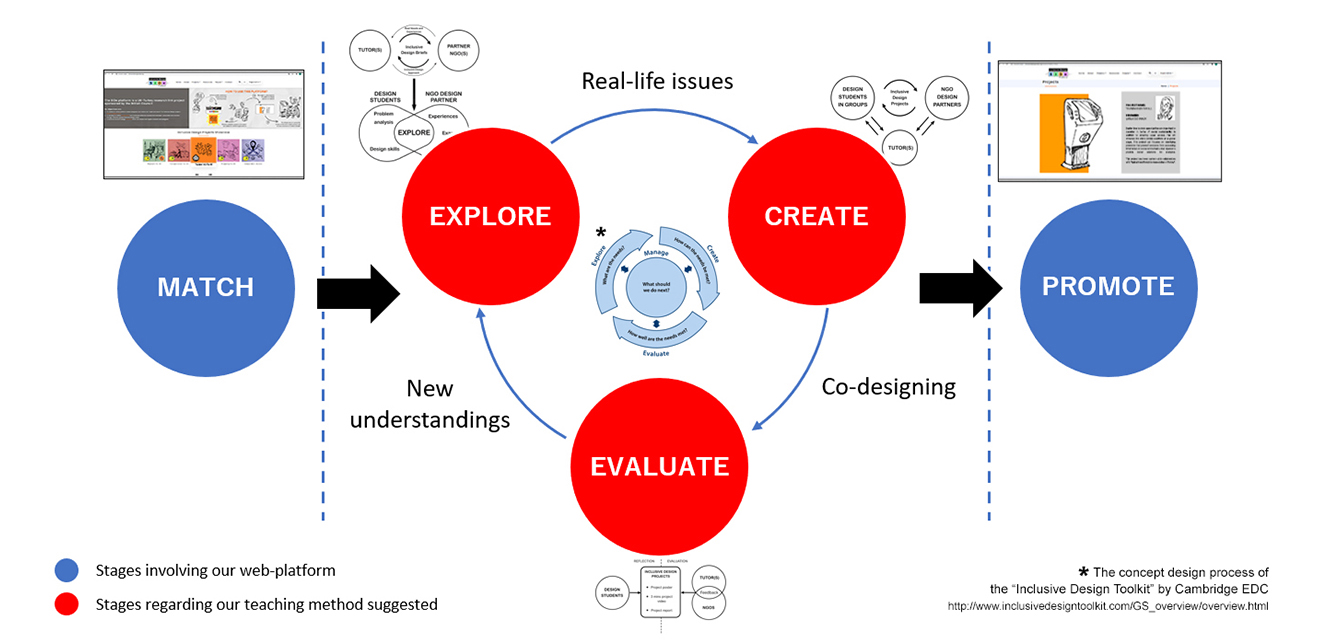GUIDANCE FOR DESIGNERS
On this page, we have prepared a guide for “design students” when their institutions carrying out collaborations with NGOs within the scope of design education focussing on inclusive design studies and use our recommended method. If you are a professional designer, please look at the bottom of this page to get information about how you can contribute to the projects on our platform.
FOR DESIGN STUDENTS:
Besides teaching inclusive design in design-related degrees, collaborations with NGO(s) not only provide design students with a perspective on social responsibility and volunteering but also provide a chance to observe how these organisations deal with «real-life» issues in the society. In this respect, design is a powerful tool that can enable the elimination of many accessibility problems encountered on a large scale in our daily lives, from products to architectural structures and environmental arrangements, and to ensure social integration for all. In this guide, you can find information about the process that you will go through during your inclusive design project development process, understand its stages, and see our recommendations regarding these stages. The document also provides introductory information about inclusive design, as well as clarify the roles of the actors who will be involved in the process.
DOWNLOAD OUR GUIDANCE FOR DESIGN STUDENTS
In summary, our model covers identifying "design briefs" that focus on real-life needs in NGO-University cooperation giving these design briefs to students as a task in their related course(s), and students’ cooperation with voluntary members from the relevant NGO throughout their design process. The cooperation process we propose adopts an “inclusive design” approach.
Our web-platform, which is an important component of our model that consists of 5 stages, provides the visibility of the developed student projects and the collaboration carried out with NGOs in the field of social responsibility. To develop this model, we adopted the concept design process developed by Cambridge EDC in their “Inclusive Design Toolkit”.
 The stages of our collaboration approach are summarised below. You can find more detailed information in the guidance document.
The stages of our collaboration approach are summarised below. You can find more detailed information in the guidance document.
1) MATCH: (This stage is carried out by University and NGO representatives, prior to design student involvement) An NGO or a University representative visits our platform as a collaboration initiator and finds guidance about our collaboration model. Our model uses an inclusive design project development process to provide mutual benefits to both universities and NGOs through effective collaboration, which uses design education and volunteer student involvement. In this respect, the first stage covers establishing a partnership between an NGO and a University. A list of NGOs and universities that previously used our model or the others that are open tor collaborations can be found under the “Participants” section.
2) EXPLORE: After establishing the partnership, the NGO representative works together with the tutor(s) to develop design briefs that both focus on real-life requirements that the NGO deal with and meet the course requirements in which the design students enrolled. Students work in groups and together with a design partner (who will be a beneficiary of the final design solution) from the partnering NGO to explore the design briefs in an effort to understand the problem area to respond with their design skills in the following stage.
3) CREATE: In this stage, co-design between the student team and their design partner is key and the team must develop a planned approach to enable this. Whilst it is the responsibility of the student team to lead this interactive process with their design partner, they will be supported by their tutors by discussing their progress and plans as well as assisting them in addressing any arising challenges.
4) EVALUATE: At the end of the project development stage, a “presentation day” is organised for design students to present the co-design projects that they have developed with their NGO partners, and share their unique experiences. In this way, students can observe the experiences of other study groups that focussed on different design briefs.
5) PROMOTE: After the projects are completed, they can be uploaded to our web-platform as “completed projects”. The consensus on the confidentiality of project outputs and personal information should also be taken between the NGO and the University. The outcoming projects will help raise awareness of the problems that students focus on. Design students can create a profile by registering to our web-platform, and if they wish, they can share information about themselves under the "Designers" page, which can be seen under the “Participants” section.
FOR PROFESSIONAL DESIGNERS:
Our platform intends to provide design solutions to real-life requirements to overcome inequities in society and raise awareness of inclusive design. If you are a professional designer who would like to voluntarily contribute a design work to one of the inclusive design briefs presented on our platform homepage, then this is very easy. Please follow the steps below: